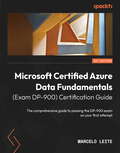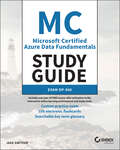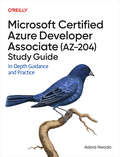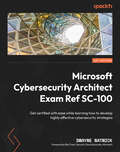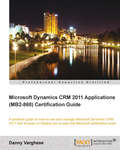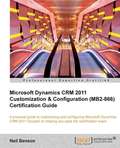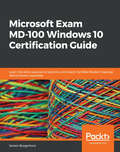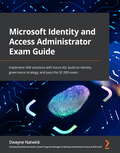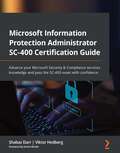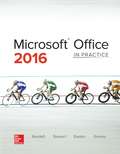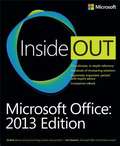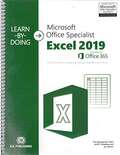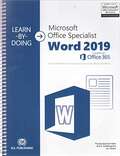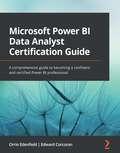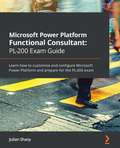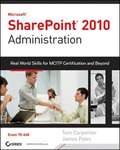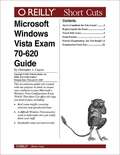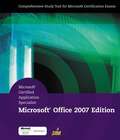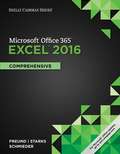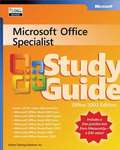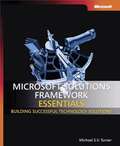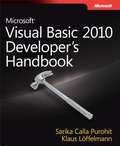- Table View
- List View
Microsoft Certified Azure Data Fundamentals (Exam DP-900) Certification Guide: The comprehensive guide to passing the DP-900 exam on your first attempt
by Marcelo LeiteLearn how to implement successful Azure Data projects and get the skills to clear the DP-900 certification exam with the help of mock tests and self-assessment scenarios for better preparationKey FeaturesGet the knowledge you need to pass the DP-900 exam on your first attemptGain fundamental knowledge of the core concepts of working with data in Azure cloud data servicesLearn through a practical approach and test yourself with mock exams at the end of the bookBook DescriptionPassing the DP-900 Microsoft Azure Data Fundamentals exam opens the door to a myriad of opportunities for working with data services in the cloud. But it is not an easy exam and you'll need a guide to set you up for success and prepare you for a career in Microsoft Azure.Absolutely everything you need to pass the DP-900 exam is covered in this concise handbook. After an introductory chapter covering the core terms and concepts, you'll go through the various roles related to working with data in the cloud and learn the similarities and differences between relational and non-relational databases. This foundational knowledge is crucial, as you'll learn how to provision and deploy Azure's relational and non-relational services in detail later in the book. You'll also gain an understanding of how to glean insights with data analytics at both small and large scales, and how to visualize your insights with Power BI. Once you reach the end of the book, you'll be able to test your knowledge with practice tests with detailed explanations of the correct answers.By the end of this book, you will be armed with the knowledge and confidence to not only pass the DP-900 exam but also have a solid foundation from which to embark on a career in Azure data services.What you will learnExplore the concepts of IaaS and PaaS database services on AzureQuery, insert, update, and delete relational data using SQLExplore the concepts of data warehouses in AzurePerform data analytics with an Azure Synapse Analytics workspaceUpload and retrieve data in Azure Cosmos DB and Azure HDInsightProvision and deploy non-relational data services in AzureContextualize the knowledge with real-life use casesTest your progress with a mock examWho this book is forThis book is for data engineers, database administrators, or aspiring data professionals getting ready to take the DP-900 exam. It will also be helpful for those looking for a bit of guidance on how to be better equipped for Azure-related job roles such as Azure database administrator or Azure data engineer. A basic understanding of core data concepts and relational and non-relational data will help you make the most out of this book, but they're not a pre-requisite.
Microsoft Certified Azure Data Fundamentals Study Guide: Exam DP-900
by Jake SwitzerThe most authoritative and complete study guide for people beginning to work with data in the Azure cloud In MC Azure Data Fundamentals Study Guide: Exam DP-900, expert Cloud Solution Architect Jake Switzer delivers a hands-on blueprint to acing the DP-900 Azure data certification. The book prepares you for the test – and for a new career in Azure data analytics, architecture, science, and more – with a laser-focus on the job roles and responsibilities of Azure data professionals. You’ll receive a foundational knowledge of core data concepts, like relational and non-relational data and transactional and analytical data workloads, while diving deep into every competency covered on the DP-900 exam. You’ll also get: Access to complimentary online study tools, including hundreds of practice exam questions, electronic flashcards, and a searchable glossary Additional prep assistance with access to Sybex’s superior interactive online learning environment and test bank Walkthroughs of skills and knowledge that are absolutely necessary for current and aspiring Azure data pros in introductory rolesPerfect for anyone just beginning to work with data in the cloud, MC Azure Data Fundamentals Study Guide: Exam DP-900 is a can’t-miss resource for anyone prepping for the DP-900 exam or considering a new career working with Azure data.
Microsoft Certified Azure Developer Associate (AZ-204) Study Guide: In-Depth Guidance and Practice
by Adora NwodoWith the recent generative AI boom, organizations are investing more resources into adapting artificial intelligence into their workloads, making the demand for AI skills higher than ever. With Microsoft Azure leading the pack with services for developing and deploying AI solutions, professionals looking to break into this field would be wise to start their journey by getting certified as an Azure AI Engineer. But Azure's AI-102 exam isn't a piece of cake. This comprehensive study guide provides everything you need to know to pass the exam with flying colors. Packed with expert guidance on how to approach the exam, apply the best study tactics, and more, this book thoroughly covers all six exam domains and takes you one step closer to certification. Author Renaldi Gondosubroto helps you understand all phases of AI solutions development, from requirements definition and design to development, deployment, and integration, along with maintenance, performance tuning, and monitoring throughout. The book then walks you through ways to implement these systems, including decision support, computer vision, natural language processing, knowledge mining, document intelligence, and generative AI solutions. With this book, you will: Understand the core concepts of Azure AI Services Learn how to develop and deploy AI solutions within Microsoft Azureâ??s environment Understand integration and security practices with Microsoftâ??s Azure AI Services Learn how to optimize and troubleshoot AI models on Microsoft Azure Know what knowledge and skills are covered on the testâ??and what to expect on exam day Renaldi Gondosubroto is an accomplished software engineer and developer advocate in the tech community, with more than a decade of experience in developing AI solutions. He holds a Master of Science in Computer Science from Columbia University and all 22 certifications in Microsoft Azure.
Microsoft Cybersecurity Architect Exam Ref SC-100: Get certified with ease while learning how to develop highly effective cybersecurity strategies
by Dwayne Natwick Rod TrentAdvance your knowledge of architecting and evaluating cybersecurity services to tackle day-to-day challengesKey FeaturesGain a deep understanding of all topics covered in the SC-100 examBenefit from practical examples that will help you put your new knowledge to workDesign a zero-trust architecture and strategies for data, applications, access management, identity, and infrastructureBook DescriptionMicrosoft Cybersecurity Architect Exam Ref SC-100 is a comprehensive guide that will help cybersecurity professionals design and evaluate the cybersecurity architecture of Microsoft cloud services. Complete with hands-on tutorials, projects, and self-assessment questions, you'll have everything you need to pass the SC-100 exam. This book will take you through designing a strategy for a cybersecurity architecture and evaluating the governance, risk, and compliance (GRC) of the architecture. This will include cloud-only and hybrid infrastructures, where you'll learn how to protect using the principles of zero trust, along with evaluating security operations and the overall security posture. To make sure that you are able to take the SC-100 exam with confidence, the last chapter of this book will let you test your knowledge with a mock exam and practice questions. By the end of this book, you'll have the knowledge you need to plan, design, and evaluate cybersecurity for Microsoft cloud and hybrid infrastructures, and pass the SC-100 exam with flying colors.What you will learnDesign a zero-trust strategy and architectureEvaluate GRC technical strategies and security operations strategiesDesign security for infrastructureDevelop a strategy for data and applicationsUnderstand everything you need to pass the SC-100 exam with easeUse mock exams and sample questions to prepare for the structure of the examWho this book is forThis book is for a wide variety of cybersecurity professionals – from security engineers and cybersecurity architects to Microsoft 365 administrators, user and identity administrators, infrastructure administrators, cloud security engineers, and other IT professionals preparing to take the SC-100 exam. It's also a good resource for those designing cybersecurity architecture without preparing for the exam. To get started, you'll need a solid understanding of the fundamental services within Microsoft 365, and Azure, along with knowledge of security, compliance, and identity capabilities in Microsoft and hybrid architectures.
Microsoft Cybersecurity Architect Exam Ref SC-100: Get certified with ease while learning how to develop highly effective cybersecurity strategies
by Dwayne NatwickAdvance your knowledge of architecting and evaluating cybersecurity services to tackle day-to-day challengesKey FeaturesGain a deep understanding of all topics covered in the SC-100 examBenefit from practical examples that will help you put your new knowledge to workDesign a zero-trust architecture and strategies for data, applications, access management, identity, and infrastructureBook DescriptionMicrosoft Cybersecurity Architect Exam Ref SC-100 is a comprehensive guide that will help cybersecurity professionals design and evaluate the cybersecurity architecture of Microsoft cloud services. Complete with hands-on tutorials, projects, and self-assessment questions, you’ll have everything you need to pass the SC-100 exam. This book will take you through designing a strategy for a cybersecurity architecture and evaluating the governance, risk, and compliance (GRC) of the architecture. This will include cloud-only and hybrid infrastructures, where you’ll learn how to protect using the principles of zero trust, along with evaluating security operations and the overall security posture. To make sure that you are able to take the SC-100 exam with confidence, the last chapter of this book will let you test your knowledge with a mock exam and practice questions. By the end of this book, you’ll have the knowledge you need to plan, design, and evaluate cybersecurity for Microsoft cloud and hybrid infrastructures, and pass the SC-100 exam with flying colors.What you will learnDesign a zero-trust strategy and architectureEvaluate GRC technical strategies and security operations strategiesDesign security for infrastructureDevelop a strategy for data and applicationsUnderstand everything you need to pass the SC-100 exam with easeUse mock exams and sample questions to prepare for the structure of the examWho this book is forThis book is for a wide variety of cybersecurity professionals – from security engineers and cybersecurity architects to Microsoft 365 administrators, user and identity administrators, infrastructure administrators, cloud security engineers, and other IT professionals preparing to take the SC-100 exam. It’s also a good resource for those designing cybersecurity architecture without preparing for the exam. To get started, you’ll need a solid understanding of the fundamental services within Microsoft 365, and Azure, along with knowledge of security, compliance, and identity capabilities in Microsoft and hybrid architectures.
Microsoft Dynamics CRM 2011 Applications (MB2-868) Certification Guide
by Danny VargheseThis Certification guide will follow a step-by-step approach to instruct the reader what they need to know to be able to become certified with Microsoft Dynamics CRM 2011.If you will implement Microsoft Dynamics CRM 2011, this book is for you. You should have a working knowledge of Microsoft Windows, Microsoft Internet Explorer, and Microsoft Office.
Microsoft Dynamics CRM 2011 Customization & Configuration (MB2-866) Certification Guide
by Neil BensonThis book is in the Enterprise certification series which means it is a hands-on guide with practical instruction, examples and all the information you will need to be successful in the exam, as well as 75 practice questions in the exam style. It includes practical advice on how to book the exam, approach the questions and maximize your score. "Microsoft Dynamics CRM 2011 Customization & Configuration (MB2-866) Certification Guide" is perfect for IT professionals and developers who work for a Microsoft partner or customer organizations. If you want to demonstrate your expertise and advance your career by obtaining Microsoft certification this book will provide you with the insight you need to succeed.
Microsoft Exam MD-100 Windows 10 Certification Guide: Learn the skills required to become a Microsoft Certified Modern Desktop Administrator Associate
by Jeroen BurgerhoutAn administrator's guide to deploying, configuring, securing, managing, and monitoring devices and client applications in an enterprise environment and passing Exam MD-100: Windows 10 easily Key Features Equip yourself to earn the Microsoft 365 Certified: Modern Desktop Administrator Associate certification Develop the skills needed to pass the Exam MD-100 and advance in your organization Learn to install Windows 10 operating systems and deploy and manage modern desktops and devices Book Description Microsoft Exam MD-100 Windows 10 Certification Guide offers complete, up-to-date coverage of the MD-100 exam, helping you take the exam with confidence, fully equipped to pass on the first attempt. Complete with a clear, succinct explanation of key concepts, self-assessment questions, tips, and mock exams with detailed answers, this MD-100 study guide covers different facets of upgrading and deploying Windows 10. You'll learn how to manage devices and data, configure connectivity, troubleshoot OS and app problems, and secure and maintain Windows 10 with updates and recovery. You'll also explore different Windows 10 editions and learn how to choose the best fit for your organization. This book will guide you in installing and configuring Windows 10 using different approaches. As you advance, you'll get to grips with managing local users and groups in Windows 10 and learn how to establish connections via different networks, such as a LAN and WLAN/Wi-Fi. By the end of this book, you'll have covered everything you need to pass the MD-100 certification exam and become a Microsoft 365 Certified: Modern Desktop Administrator Associate. What you will learn Deploy Windows 10 in a variety of ways Manage local users, groups, and devices Configure networking and remote connectivity Gain insights into Windows 10 maintenance Customize different Windows 10 features Become an expert at troubleshooting and recovery Get to grips with managing log files Monitor and manage Windows security Who this book is for This book is for both experienced and novice IT administrators who work with deploying, configuring, securing, and monitoring devices. Anyone with a working knowledge of managing identity, access, policies, updates, and apps can take this exam. Although not necessary, experience with Microsoft 365 workloads, Windows 10 devices, and non-Windows devices will be helpful.
Microsoft Exam MD-100 Windows 10 Certification Guide: Learn the skills required to become a Microsoft Certified Modern Desktop Administrator Associate
by Jeroen BurgerhoutAn administrator s guide to deploying, configuring, securing, managing, and monitoring devices and client applications in an enterprise environment and passing Exam MD-100: Windows 10 easilyKey FeaturesEquip yourself to earn the Microsoft 365 Certified: Modern Desktop Administrator Associate certificationDevelop the skills needed to pass the Exam MD-100 and advance in your organizationLearn to install Windows 10 operating systems and deploy and manage modern desktops and devicesBook DescriptionMicrosoft Exam MD-100 Windows 10 Certification Guide offers complete, up-to-date coverage of the MD-100 exam, helping you take the exam with confidence, fully equipped to pass on the first attempt. Complete with a clear, succinct explanation of key concepts, self-assessment questions, tips, and mock exams with detailed answers, this MD-100 study guide covers different facets of upgrading and deploying Windows 10. You’ll learn how to manage devices and data, configure connectivity, troubleshoot OS and app problems, and secure and maintain Windows 10 with updates and recovery. You’ll also explore different Windows 10 editions and learn how to choose the best fit for your organization. This book will guide you in installing and configuring Windows 10 using different approaches. As you advance, you’ll get to grips with managing local users and groups in Windows 10 and learn how to establish connections via different networks, such as a LAN and WLAN/Wi-Fi. By the end of this book, you'll have covered everything you need to pass the MD-100 certification exam and become a Microsoft 365 Certified: Modern Desktop Administrator Associate.What you will learnDeploy Windows 10 in a variety of waysManage local users, groups, and devicesConfigure networking and remote connectivityGain insights into Windows 10 maintenanceCustomize different Windows 10 featuresBecome an expert at troubleshooting and recoveryGet to grips with managing log filesMonitor and manage Windows securityWho this book is forThis book is for both experienced and novice IT administrators who work with deploying, configuring, securing, and monitoring devices. Anyone with a working knowledge of managing identity, access, policies, updates, and apps can take this exam. Although not necessary, experience with Microsoft 365 workloads, Windows 10 devices, and non-Windows devices will be helpful.
Microsoft Identity and Access Administrator Exam Guide: Implement IAM solutions with Azure AD, build an identity governance strategy, and pass the SC-300 exam
by Dwayne Natwick Shannon KuehnThis certification guide focuses on identity solutions and strategies that will help you prepare for Microsoft Identity and Access Administrator certification, while enabling you to implement what you've learned in real-world scenariosKey FeaturesDesign, implement, and operate identity and access management systems using Azure ADProvide secure authentication and authorization access to enterprise applicationsImplement access and authentication for cloud-only and hybrid infrastructuresBook DescriptionCloud technologies have made identity and access the new control plane for securing data. Without proper planning and discipline in deploying, monitoring, and managing identity and access for users, administrators, and guests, you may be compromising your infrastructure and data. This book is a preparation guide that covers all the objectives of the SC-300 exam, while teaching you about the identity and access services that are available from Microsoft and preparing you for real-world challenges.The book starts with an overview of the SC-300 exam and helps you understand identity and access management. As you progress to the implementation of IAM solutions, you'll learn to deploy secure identity and access within Microsoft 365 and Azure Active Directory. The book will take you from legacy on-premises identity solutions to modern and password-less authentication solutions that provide high-level security for identity and access. You'll focus on implementing access and authentication for cloud-only and hybrid infrastructures as well as understand how to protect them using the principles of zero trust. The book also features mock tests toward the end to help you prepare effectively for the exam.By the end of this book, you'll have learned how to plan, deploy, and manage identity and access solutions for Microsoft and hybrid infrastructures.What you will learnUnderstand core exam objectives to pass the SC-300 examImplement an identity management solution with MS Azure ADManage identity with multi-factor authentication (MFA), conditional access, and identity protectionDesign, implement, and monitor the integration of enterprise apps for Single Sign-On (SSO)Add apps to your identity and access solution with app registrationDesign and implement identity governance for your identity solutionWho this book is forThis book is for cloud security engineers, Microsoft 365 administrators, Microsoft 365 users, Microsoft 365 identity administrators, and anyone who wants to learn identity and access management and gain SC-300 certification. You should have a basic understanding of the fundamental services within Microsoft 365 and Azure Active Directory before getting started with this Microsoft book.
Microsoft Information Protection Administrator SC-400 Certification Guide: Advance your Microsoft Security & Compliance services knowledge and pass the SC-400 exam with confidence
by Shabaz Darr Viktor HedbergDiscover how to implement information protection, data loss prevention, and information governance within Microsoft 365Key FeaturesDesign, implement, and administer Microsoft Information ProtectionImplement data loss prevention to minimize the risk of data exfiltrationUse Information Governance capabilities to ensure that data is stored in your environment for as long as necessaryBook DescriptionCloud technologies have massively increased the amount of data being produced and the places in which this data is stored. Without proper planning and discipline in configuring information protection for your data, you may be compromising information and regulatory compliance.Microsoft Information Protection Administrator SC-400 Certification Guide begins with an overview of the SC-400 exam, and then enables you to envision, implement, and administer the Information Protection suite offered by Microsoft. The book also provides you with hands-on labs, along with the theory of creating policies and rules for content classification, data loss prevention, governance, and protection. Toward the end, you'll be able to take mock tests to help you prepare effectively for the exam.By the end of this Microsoft book, you'll have covered everything needed to pass the SC-400 certification exam, and have a handy, on-the-job desktop reference guide.What you will learnUnderstand core exam objectives to pass the SC-400 exam with easeFind out how to create and manage sensitive information types for different types of dataCreate and manage policies and learn how to apply these to Microsoft 365 SaaS applicationsBroaden your knowledge of data protection on M365Discover how to configure and manage the protection of your data in M365Monitor activity regarding data access in M365Understand and implement Data Governance in M365Who this book is forIf you are a compliance administrator, Microsoft 365 Administrator, or Information Protection Administrator who wants to improve their knowledge of Microsoft Security & Compliance services, then this book is for you. This book is also ideal for anyone looking to achieve the SC-400 Information Protection Associate Administrator certification.
Microsoft Office 2016: In Practice
by Kathleen Stewart Randy Nordell Moraine Valley Annette Easton Pat GravesMicrosoft Office 2016: In Practice offers a fresh approach to teaching today's students Microsoft Office skills by clearly introducing skills in a logical sequence: 1) Topic 2) Instruction and 3) Practice. Nordell's T.I.P.s approach builds a foundation for success by helping students practice what they learn, and provides transferable skills that allow students to grasp critical thinking beyond the textbook assignment. In Practice seamlessly integrates with SIMnet Online, McGraw-Hill Education's learning and assessment solution, which has 1:1 content to help students practice and master computing concepts and Microsoft Office skills.
Microsoft Office Inside Out: 2013 Edition
by Carl Siechert Ed BottConquer Microsoft Office--from the inside out! You're beyond the basics, so dive right into Microsoft Office--and really put these productivity tools and services to work! This supremely organized reference packs hundreds of timesaving solutions, troubleshooting tips, and workarounds. It's all muscle and no fluff. Discover how the experts tackle Office--and challenge yourself to new levels of mastery. Take advantage of Office in the cloud with Office 365 Get insider tweaks and tips to become more productive Sync your email, calendar, and contacts on multiple devices Organize and edit complex documents with Microsoft Word Enhance Microsoft PowerPoint presentations with rich media Handle data with the Microsoft Excel Quick Analysis tool Get organized with Microsoft OneNote using expert techniques Save, share, and sync documents and settings with SkyDrive Use Microsoft Access, Publisher, and Lync in smarter ways
Microsoft Office Specialist Excel 2019
by The Development Team at B.E. Publishing and Joy TavanoDesigned for today's interactive, visual learner, this text consists of graphical hands-on lessons that get students instantly engaged in applying Microsoft Excel 2019 skills. Students will learn how to format data, work with numbers and formulas, and create charts and graphs as they acquire the skills needed for school and workplace readiness.
Microsoft Office Specialist Word 2019
by The Development Team at B.E. Publishing and Joy TavanoDesigned for today's interactive, visual learner, this text consists of graphical hands-on lessons that get students instantly engaged in applying Microsoft Word 2019 skills. Students will learn how to format text and paragraphs, work with tables, and design sophisticated multi-page documents as they explore the powerful features and interface of Word 2019.
Microsoft Power BI Data Analyst Certification Guide: A comprehensive guide to becoming a confident and certified Power BI professional
by Orrin Edenfield Edward CorcoranGain the knowledge and skills needed to become a certified Microsoft Power BI data analyst and get the most out of Power BIKey FeaturesGet the skills you need to pass the PL-300 certification exam with confidenceCreate and maintain robust reports and dashboards to enable a data-driven enterpriseTest your new BI skills with the help of practice questionsBook DescriptionMicrosoft Power BI enables organizations to create a data-driven culture with business intelligence for all. This guide to achieving the Microsoft Power BI Data Analyst Associate certification will help you take control of your organization's data and pass the exam with confidence.From getting started with Power BI to connecting to data sources, including files, databases, cloud services, and SaaS providers, to using Power BI's built-in tools to build data models and produce visualizations, this book will walk you through everything from setup to preparing for the certification exam. Throughout the chapters, you'll get detailed explanations and learn how to analyze your data, prepare it for consumption by business users, and maintain an enterprise environment in a secure and efficient way.By the end of this book, you'll be able to create and maintain robust reports and dashboards, enabling you to manage a data-driven enterprise, and be ready to take the PL-300 exam with confidence.What you will learnConnect to and prepare data from a variety of sourcesClean, transform, and shape your data for analysisCreate data models that enable insight creationAnalyze data using Microsoft Power BI's capabilitiesCreate visualizations to make analysis easierDiscover how to deploy and manage Microsoft Power BI assetsWho this book is forThis book is for data analysts and BI professionals who want to become more competent in Microsoft Power BI. Although the content in this book will help you pass the PL-300 exam, there are plenty of other practical applications beyond exam preparation in the chapters. No prior experience with Power BI is needed.
Microsoft Power Platform Functional Consultant: Learn how to customize and configure Microsoft Power Platform and prepare for the PL-200 exam
by Julian SharpGet up to speed with expert tips, techniques, and the latest insights to confidently take the PL-200 examKey FeaturesLearn effectively with the help of self-assessment questions, mock tests, and detailed explanations in this up-to-date study guideAddress the challenges faced by a functional consultant in day-to-day activitiesUnderstand how to configure, customize, and implement solutions based on Power PlatformBook DescriptionThe Power Platform Functional Consultant Associate (PL-200) exam tests and validates the practical skills of Power Platform users who are proficient in developing solutions by combining the tools in Power Platform and the Microsoft 365 ecosystem based on business needs. This certification guide offers complete, up-to-date coverage of the PL-200 exam so you can prepare effectively for the exam. Written in a clear, succinct way with self-assessment questions, exam tips, and mock exams with detailed explanations of solutions, this book covers common day-to-day activities involved in configuring Power Platform, such as managing entities, creating apps, implementing security, and managing system change. You'll also explore the role of a functional consultant in creating a data model in the Microsoft Dataverse (formerly Common Data Service). Moving ahead, you'll learn how to design the user experience and even build model-driven and canvas apps. As you progress, the book will show you how to manage automation and create chatbots. Finally, you'll understand how to display your data with Power BI and integrate Power Platform with Microsoft 365 and Microsoft Teams. By the end of this book, you'll be well-versed with the essential concepts and techniques required to prepare for the PL-200 certification exam.What you will learnUnderstand how to build apps that meet customer needsExtend the schema for Dataverse with entities, fields, and relationshipsCreate and configure automations to simplify user activitiesExplore various security features in Power Platform and learn how to implement themUse multiple data sources to create task- or role-based web and mobile applications for usersAutomate business processes and enhance the user experience with Power Automate and UI FlowsIntegrate various applications within the Microsoft ecosystem with Power PlatformWho this book is forThis book is for functional consultants and business analysts who are involved in implementing solutions based on Power Platform or Dynamics 365. As the PL-200 exam is a pre-requisite for other role-based certifications in Power Platform and Microsoft Dynamics 365, individuals pursuing their careers in these domains will also find this book helpful. Basic knowledge of Power Platform and access to a Power Platform environment are required to get started with this book.
Microsoft SharePoint 2010 Administration
by James Pyles Tom CarpenterDelivers the information that SharePoint 2010 administrators in the field need mostThis book shows you how to design, deploy, and implement a SharePoint 2010 environment, providing practical skills and real-world techniques and scenarios you'll be able to apply on the job. You'll not only thoroughly learn SharePoint 2010, but you'll also get up to speed on business continuity and solutions. In addition, those preparing for the MCITP: SharePoint 2010 Administration certification exam 70-668 will find thorough coverage of all exam objectives.Shows you how to design, deploy, administer, and maintain a SharePoint Server 2010 infrastructureGuides readers through preparation for Microsoft SharePoint 2010, Administrator (Exam 70-668)Includes techniques and instructional videos from industry expert and lead author, Tom Carpenter, a well-known author and instructor.Companion CD includes over an hour of video instruction on some of the more difficult topics, as well as practice exams, flashcards, and moreIf you're preparing for MCITP exam 70-668, as well as a career as a SharePoint 2010 administrator, this is a book you'll want.
Microsoft Windows Vista Exam 70-620 Guide
by Christopher A. CraytonThis no-nonsense guide was created with one purpose in mind: to ensure your readiness to pass Microsoft's Windows Vista Configuration Exam 70-620. This Short Cut offers the edge you need to pass, including:Real exam insight, covering structure and question formatsA difficult Windows Vista practice exam to help make sure you really know your stuffInvaluable exam survival test tips
Microsoft® Certified Application Specialist: Microsoft® Office 2007 Edition
by Pam Conrad Jennifer T. Campbell Barbara Clemens Lisa Ruffolo Rachel Biheller BuninNIMAC-sourced textbook
Microsoft® Excel® 2016: Comprehensive (Shelly Cashman)
by Joy L. Starks Steven M. Freund Eric J. SchmiederIntroduce your students to the latest advancements that Microsoft® Office and Excel 2016 have to offer with MICROSOFT® OFFICE 365 & EXCEL 2016: COMPREHENSIVE -- the new edition in the acclaimed Shelly Cashman Series®. For more than three decades, the Shelly Cashman Series® has effectively introduced computer skills to millions. MICROSOFT® OFFICE 365 & EXCEL 2016: COMPREHENSIVE continues the Series’ strong history of innovation with a hallmark learning approach now enhanced to address the varied learning styles of today’s students. A trademark, step-by-step, screen-by-screen approach provides a thorough understanding of Microsoft® Excel 2016 through experimentation, critical thought, and personalization. This new edition and accompanying resources deliver effective educational materials specifically designed to engage readers, improve retention, and prepare students for future success in working with all aspects of Excel 2016.
Microsoft® Office Specialist Study Guide Office 2003 Edition
by Joan Lambert Joyce CoxDemonstrate your expertise with Microsoft Office! Designed to help you practice and prepare for Microsoft Office Specialist certification, this easy-to-use study guide features: Step-by-step exercises for building and strengthening your skills Practice files on CD End-of-chapter objective reviews MeasureUp practice test to assess your exam readiness With in-depth preparation for all the exam objectives on the Microsoft Office 2003 Editions track, including both core- and expert-level certifications, you'll gain the skills and knowledge you need to help you ace the exam! Includes one free practice test from MeasureUp! Take an online skills test--looks and scores like the certification exam Test yourself within the real application Get feedback on correct and incorrect answers Identify where you need to focus your study time Covers all the exam objectives for: Microsoft Office Word 2003 Core Microsoft Office Word 2003 Expert Microsoft Office Excel 2003 Core Microsoft Office Excel 2003 Expert Microsoft Office PowerPoint 2003 Microsoft Office Access 2003 Microsoft Office Outlook 2003 A Note Regarding the CD or DVD The print version of this book ships with a CD or DVD. For those customers purchasing one of the digital formats in which this book is available, we are pleased to offer the CD/DVD content as a free download via O'Reilly Media's Digital Distribution services. To download this content, please visit O'Reilly's web site, search for the title of this book to find its catalog page, and click on the link below the cover image (Examples, Companion Content, or Practice Files). Note that while we provide as much of the media content as we are able via free download, we are sometimes limited by licensing restrictions. Please direct any questions or concerns to booktech@oreilly.com.
Microsoft® OneNote In One Hour for Lawyers
by Ben M. SchorrEach copy of Microsoft® Office 2010 sold now includes OneNote, and its usage among lawyers is poised to skyrocket. With this guide, learn to use OneNote in your law practice to save time and increase productivity. Microsoft® OneNote in One Hour for Lawyers will explain, in plain English, how to get started with the software, develop best practices, and become far more effective in your note-taking and research.
Microsoft® Solutions Framework Essentials
by Michael S. V. TurnerGet the definitive guide to learning the foundational principles, mindsets, and best practices of the Microsoft Solutions Framework (MSF), Version 4. Written by a solutions delivery expert, this hands-on guide offers practical examples and case studies to help you apply this adaptable, scalable framework to any project and effectively implement business-driven technology solutions. Discover how to: Establish an adaptable and flexible solution delivery life cycle Incrementally define, design, build, stabilize and deploy solutions that address business needs Implement a dynamic team model that promotes team agility Manage solution delivery readiness at the individual, project team, and organizational level Proactively minimize project risks Meet release criteria and validate stakeholder expectations and user needs Use governance activities and checkpoints at each stage of your project
Microsoft® Visual Basic® 2010 Developer's Handbook
by Klaus Löffelmann Sarika Calla PurohitYour expert guide to building modern applications with Visual Basic 2010 Take control of Visual Basic 2010--for everything from basic Windows® and web development to advanced multithreaded applications. Written by Visual Basic experts, this handbook provides an in-depth reference on language concepts and features, as well as scenario-based guidance for putting Visual Basic to work. It's ideal whether you're creating new applications with Visual Basic 2010 or upgrading projects built with an earlier version of the language. Discover how to: Use Visual Basic 2010 for Windows Forms and Windows Presentation Foundation projects Build robust code using object-oriented programming techniques, such as classes and types Work with events and delegates--and add your own events to custom classes Program arrays, collections, and other data structures in the Microsoft .NET Framework Solve problems quickly and easily using My namespace in Visual Basic Dive into Microsoft LINQ, including LINQ to XML and LINQ to Entities Tackle threading, multitasking, and multiprocessor development and debugging
